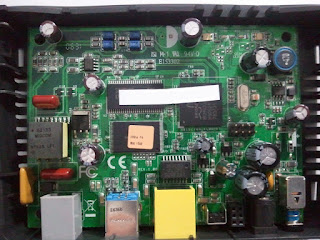Una vez finalizado el arranque, si pulsamos una tecla solicita un login y contraseña.
login: admin
Password: admin
Aparece un menú de configuración, similar al entorno web. Para moverse por los diferentes menús, se escribe el numero de la opción deseada.
Note: If you have problem with Backspace key, please make sure you configure your terminal emulator settings. For instance, from HyperTerminal you would need to use File->Properties->Setting->Back Space key sends. Main Menu 1. ADSL Link State 2. LAN 3. WAN 4. DNS Server 5. Route Setup 6. NAT 7. Firewall 8. Management 9. Passwords 10. OamDiag 11. Reset to Default 12. Save and Reboot 13. Exit -> |
13. Exit -> exit Done # |
Para conocer la lista de comandos disponibles, se escribe 'help' en la consola.
help
Built-in commands:
-------------------
. : break cd continue eval exec exit export help login newgrp
read readonly set shift times trap umask wait [ busybox cat chmod
cp date df dmesg echo expr false ifconfig init insmod kill klogd
linuxrc ln logger logread mkdir mount msh ping ps pwd reboot
rm rmmod route sendarp sh sysinfo syslogd test tftp tftpd top
true tty vconfig
#
|
El comando 'ls' no esta disponible, pero por suerte con el comando 'echo *' se puede listar la estructura de directorios.
echo * echo bin dev etc lib linuxrc mnt proc sbin usr var webs webs-English # |
Información del procesador.
cat /proc/cpuinfo system type : F@ST1201S processor : 0 cpu model : BCM6338 V1.0 BogoMIPS : 239.20 wait instruction : no microsecond timers : yes tlb_entries : 32 extra interrupt vector : yes hardware watchpoint : no VCED exceptions : not available VCEI exceptions : not available # |
Información de la memoria RAM.
cat /proc/meminfo MemTotal: 6124 kB MemFree: 388 kB Buffers: 224 kB Cached: 1640 kB SwapCached: 0 kB Active: 1888 kB Inactive: 620 kB HighTotal: 0 kB HighFree: 0 kB LowTotal: 6124 kB LowFree: 388 kB SwapTotal: 0 kB SwapFree: 0 kB Dirty: 0 kB Writeback: 0 kB Mapped: 1512 kB Slab: 1996 kB Committed_AS: 2980 kB PageTables: 200 kB VmallocTotal: 1048560 kB VmallocUsed: 964 kB VmallocChunk: 1047572 kB # |
Información del mapa actual de memoria.
cat /proc/iomem 00000000-0079ffff : System RAM 00010000-0014da53 : Kernel code 0014da54-0017c0bf : Kernel data # |
Información de los puertos registrados actualmente utilizados para la comunicación de entrada y salida con un dispositivo. La salida no devuelve ningún resultado.
cat /proc/ioports # |
Información del número de interrupciones por IRQ. Las interrupciones 21 y 23, corresponden con el USB y con el Ethernet.
cat /proc/interrupts
CPU0
7: 709410 MIPS timer
10: 1248 MIPS brcm_10
12: 0 MIPS brcm_12
13: 10549 MIPS brcm_13
14: 0 MIPS brcm_14
15: 0 MIPS brcm_15
17: 0 MIPS brcm_17
19: 0 MIPS brcm_19
21: 0 MIPS brcm_21
23: 0 MIPS brcm_23
ERR: 0
#
|
Información de la lista de módulos cargados en el sistema.
cat /proc/modules ipt_state 544 0 - Live 0xc00f5000 ipt_mark 416 0 - Live 0xc00f3000 ipt_limit 896 0 - Live 0xc00f1000 ipt_connlimit 1696 0 - Live 0xc00ef000 ipt_TCPMSS 2304 0 - Live 0xc00e8000 ipt_REDIRECT 768 0 - Live 0xc00ea000 ipt_MASQUERADE 1536 0 - Live 0xc00e4000 ipt_MARK 704 0 - Live 0xc00e6000 ipt_LOG 4064 0 - Live 0xc00ca000 ipt_FTOS 992 0 - Live 0xc00e2000 ip_nat_tftp 1888 0 - Live 0xc00e0000 ip_nat_rtsp 4816 0 - Live 0xc0047000 ip_nat_irc 2304 0 - Live 0xc00c8000 ip_nat_ftp 2976 0 - Live 0xc00ad000 ip_conntrack_tftp 1824 0 - Live 0xc00ab000 ip_conntrack_rtsp 73024 1 ip_nat_rtsp, Live 0xc00cd000 ip_conntrack_irc 68896 1 ip_nat_irc, Live 0xc00b6000 ip_conntrack_ftp 20608 1 ip_nat_ftp, Live 0xc00af000 ip_nat_ipsec 46624 0 - Live 0xc009e000 ip_conntrack_ipsec 30640 0 - Live 0xc0095000 ip_nat_h323 2208 0 - Live 0xc005f000 ip_conntrack_h323 68112 1 ip_nat_h323, Live 0xc0083000 ip_nat_pptp 2048 0 - Live 0xc005d000 ip_conntrack_pptp 3312 0 - Live 0xc004e000 ip_nat_gre 1280 0 - Live 0xc004c000 ip_conntrack_gre 2064 2 ip_nat_pptp,ip_conntrack_pptp, Live 0xc004a000 iptable_mangle 960 0 - Live 0xc001f000 iptable_nat 15248 10 ipt_REDIRECT,ipt_MASQUERADE,ip_nat_tftp,ip_nat_rtsp,ip_nat_irc,ip_nat_ftp,ip_nat_ipsec,ip_nat_h323,ip_nat_pptp,ip_nat_0 ip_conntrack 24880 20 ipt_state,ipt_connlimit,ipt_REDIRECT,ipt_MASQUERADE,ip_nat_tftp,ip_nat_rtsp,ip_nat_irc,ip_nat_ftp,ip_conntrack_tftp,i0 iptable_filter 928 1 - Live 0xc001d000 ip_tables 14144 13 ipt_state,ipt_mark,ipt_limit,ipt_connlimit,ipt_TCPMSS,ipt_REDIRECT,ipt_MASQUERADE,ipt_MARK,ipt_LOG,ipt_FTOS,iptable_mang0 bcm_usb 16144 0 - Live 0xc0008000 bcm_enet 24784 0 - Live 0xc0036000 bcmprocfs 12288 0 - Live 0xc0010000 adsldd 128688 0 - Live 0xc0062000 blaa_dd 6880 0 - Live 0xc000d000 atmapi 63056 2 adsldd,blaa_dd, Live 0xc0025000 # |
Información de las particiones del sistema.
cat /proc/mtd dev: size erasesize name mtd0: 0012a000 00002000 "Physically mapped flash" # cat /proc/partitions major minor #blocks name 31 0 1192 mtdblock0 # cat /proc/mounts rootfs / rootfs rw 0 0 /dev/root / squashfs ro 0 0 /proc /proc proc rw,nodiratime 0 0 tmpfs /var tmpfs rw 0 0 # |
Información del Kernel de Linux y gcc en uso.
cat /proc/version Linux version 2.6.8.1 (yangj@svr1.sagemharbournetworks.com) (gcc version 3.4.2) #1 Wed Nov 29 09:56:41 CST 2006 # |
Información de los dispositivos de caracter y de bloque actualmente configurados. Entre los dispositivos se encuentra el puerto serie '4 ttyS'.
cat /proc/devices Character devices: 1 mem 2 pty 3 ttyp 4 ttyS 5 /dev/tty 5 /dev/console 10 misc 108 ppp 205 atmapi 206 bcrmboard 208 adsl 212 bcm Block devices: 31 mtdblock # |
Información de los interfaces de redes.
ifconfig
br0 Link encap:Ethernet HWaddr 00:19:4b:20:00:55
inet addr:192.168.0.1 Bcast:192.168.0.255 Mask:255.255.255.0
UP BROADCAST RUNNING ALLMULTI MULTICAST MTU:1500 Metric:1
RX packets:0 errors:0 dropped:0 overruns:0 frame:0
TX packets:27 errors:0 dropped:0 overruns:0 carrier:0
collisions:0 txqueuelen:0
RX bytes:0 (0.0 B) TX bytes:1194 (1.1 KiB)
lo Link encap:Local Loopback
inet addr:127.0.0.1 Mask:255.0.0.0
UP LOOPBACK RUNNING MTU:16436 Metric:1
RX packets:0 errors:0 dropped:0 overruns:0 frame:0
TX packets:0 errors:0 dropped:0 overruns:0 carrier:0
collisions:0 txqueuelen:0
RX bytes:0 (0.0 B) TX bytes:0 (0.0 B)
nas_8_35 Link encap:Ethernet HWaddr 00:19:4b:20:00:56
UP BROADCAST RUNNING MULTICAST MTU:1500 Metric:1
RX packets:0 errors:0 dropped:0 overruns:0 frame:0
TX packets:0 errors:0 dropped:0 overruns:0 carrier:0
collisions:0 txqueuelen:1000
RX bytes:0 (0.0 B) TX bytes:0 (0.0 B)
#
|












